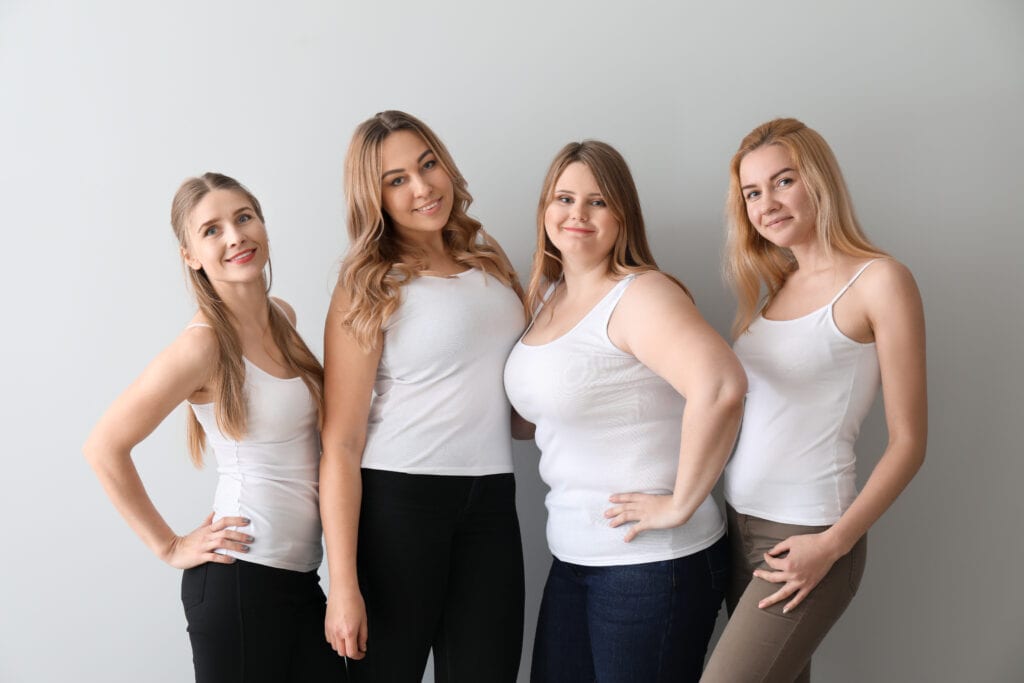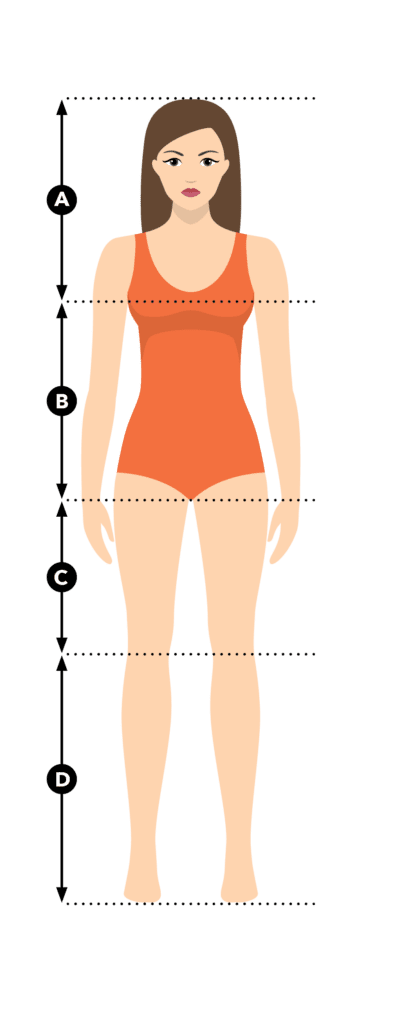
There are two elements to your body type – vertical and horizontal.
Vertical means the length of your body – how you are proportioned from head to toe.
Horizontal means the width of your body – where your body is narrower and wider.
What You’ll Need to Find Your Body Type
- Rectractable measuring tape (used for measuring a room)
- Soft measuring tape (used for sewing)
- Ruler or yard stick
- Pencil or pen and paper
- NO SHOES ON
- Wall to stand up against on a hard surface (not carpet)
PART I: Vertical Body Type
Some people have longer upper bodies while other people are longer legged. Some people have a shorter mid-body (bust to knees) while a lucky few are balanced, with equal distance in their upper, middle and lower body. Regardless of how your weight changes over time, your vertical proportions will remain the same.
Here’s a quick way to determine your vertical body type (record all measurements in inches). You can use paper or download this fillable form and print it: BodyMeasuringForm-Fillable
Step 1: Measure Your Height
Stand in front of a wall and place a ruler vertically across your head so a tip of it touches the wall. Mark a small dot with a pencil, then use a measuring tape to measure distance to the floor.
Step 2: Measure Top of Head to Bust Peak (A)
Stand straight against a wall, shoes off. Place a ruler or yardstick across your head so that one end reaches the wall. Mark the wall with a small dot.
Now, place your ruler parallel to the fullest area of your bust (nipple) and extend the ruler to the wall, making another small dot.
Using your retractable measuring tape, measure the distance between the two points. Record measurement in inches.
Step 3: Measure Bust Peak to Torso/Leg (B)
Remain standing straight against the wall. Place a ruler or yardstick across your torso at the point where your leg meets your body. Tip: move one leg slightly forward and point your toe. Where the leg bends is the Torso/Leg point. Mark the wall with a small dot.
Using your retractable measuring tape, measure the distance between the Bust Peak and the Torso/Leg dots.
Record measurement in inches.
Step 4: Measure Leg Break to Knee Cap (C)
Remain standing straight against the wall. Find the middle of your knee cap with one of your hands. Use the ruler as before, extend to wall and mark with a small dot.
Using your retractable measuring tape, measure the distance between the Torso/Leg and the Knee Cap points.
Record measurement in inches.
Step 5: Measure Knee Cap to Foot Bottom (D)
Place your retractable measuring tape at the Knee Cap dot on the wall and measure the distance to the floor (hard surface – do not stand on carpeting). Record measurement in inches.
RESULTS
The following results are as it relates to YOUR BODY proportions:
HEIGHT
- Under 5’4″ = Shorter
- 5’5″ – 5’7″ = Average
- 5’8″ and above = Tall
PROPORTIONS
- If all four areas (A-D) are the same measurement, you have a balanced body.
- If AREAS A & B (torso) measure longer than AREAS C & D (legs) – you have a longer torso for your body
- The opposite is true if AREAS C & D measure longer than AREAS A & B – you have longer legs for your body
- If AREAS A & D are the same measurement, and AREAS B & C are the same measurement, but B & C’s are shorter than A & D – you have a balanced torso and legs with a short mid-body
PART II: Horizontal Body Type
Generally speaking, there are five horizontal body types:
- Hourglass (also known as an “X”)
- Triangle (also known as an “A”, “Pear” or “Spoon”)
- Oval (also known as an “O” or “Apple” and a “Diamond”)
- Inverted Triangle (also known as an “V” or “Strawberry”)
- Rectangle (also known as an “H” or “Banana”)
Basically, these body types identify where your body goes in and out – where you’re wider or narrower.  Here’s quick way to identify your horizontal body type:
Here’s quick way to identify your horizontal body type:
Step 1: Shoulder circumference
Using your soft measuring tape, measure your shoulders as shown in diagram (right). Record measurement in inches.
Step 2: Bust circumference
Continue with the same measuring tape, measuring your bust at its widest point. Record measurement in inches.
Step 3: Waist circumference
Standing straight, bend to one side. This is your natural waist. Measure your waistline. Record measurement in inches.
Step 4: High Hip circumference
Measure a just above the curve of your hips, as shown in the diagram. Record measurement in inches.
Step 5: High Hip circumference
Measure a fullest part of your hips, going around your buttocks. Record measurement in inches.
RESULTS
Hourglass
You’re an Hourglass shape if your shoulders, bust and hip measurements are about the same and your waist is markedly smaller (10” or more than both). Typically, you have a full bust for your proportions and your hips can be full.
Triangle
You’re a Triangle shape if your shoulders, bust and waist are proportionally narrower than your hips (usually 10+ inches), which tend to be fuller along with your thighs. Your shoulders are typically narrower and your stomach is relatively flat. Your bust is usually small to medium in size.
Oval
You’re an Oval shape if your waist and bust are the widest area of your body. You have an undefined waistline and typically have a moderate to large bust. Some “O” shaped Ovals have wider shoulders and fuller hips and thighs while “Diamond” shaped Ovals tend to have narrower shoulders, hips and thighs.
Inverted Triangle
You’re an Inverted Triangle shape if you have a full bust and/or you have broad shoulders (your widest points). Your hips are narrow by comparison and you have a well-defined, narrow waist with slim legs. You may also have a flat derriere.
Rectangle
You’re a Rectangle shape if your shoulders, bust and hips are roughly the same measurement and your waist is slightly narrower, giving you little waist definition. Your legs and arms are typically slender and you have small or medium bust, often with a flat derriere.
Want a Shopping Guide for Your Body Type?
While the above information is a great guide, you may want more specifics or a little help on how to dress for your body proportions. Our Perfect Clothing Fit service includes measuring your vertical body from 12 different points as well as doing seven horizontal body measurements, resulting in a customized style portfolio that gives you clothing styles and lengths for your specific proportions. Contact us today to learn more!
